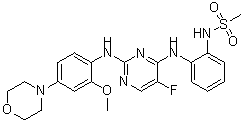CZC-25146 is a potent and selective LRRK2 inhibitor. Leucine-rich repeat kinase-2 (LRRK2) mutations are the most important cause of familial Parkinson's disease. CZC-25146 prevents mutant LRRK2-induced injury of cultured rodent and human neurons with mid-nanomolar potency.
Physicochemical Properties
| Molecular Formula | C22H25N6O4FS |
| Molecular Weight | 488.5351 |
| Exact Mass | 488.164 |
| CAS # | 1191911-26-8 |
| Related CAS # | CZC-25146 hydrochloride;1330003-04-7 |
| PubChem CID | 44252884 |
| Appearance | Pale purple to purple solid powder |
| Density | 1.4±0.1 g/cm3 |
| Boiling Point | 697.4±65.0 °C at 760 mmHg |
| Flash Point | 375.5±34.3 °C |
| Vapour Pressure | 0.0±2.2 mmHg at 25°C |
| Index of Refraction | 1.655 |
| LogP | 1.5 |
| Hydrogen Bond Donor Count | 3 |
| Hydrogen Bond Acceptor Count | 11 |
| Rotatable Bond Count | 8 |
| Heavy Atom Count | 34 |
| Complexity | 737 |
| Defined Atom Stereocenter Count | 0 |
| InChi Key | XXHHOTZUJIXPJX-UHFFFAOYSA-N |
| InChi Code | InChI=1S/C22H25FN6O4S/c1-32-20-13-15(29-9-11-33-12-10-29)7-8-19(20)26-22-24-14-16(23)21(27-22)25-17-5-3-4-6-18(17)28-34(2,30)31/h3-8,13-14,28H,9-12H2,1-2H3,(H2,24,25,26,27) |
| Chemical Name | N-[2-[[5-fluoro-2-(2-methoxy-4-morpholin-4-ylanilino)pyrimidin-4-yl]amino]phenyl]methanesulfonamide |
| HS Tariff Code | 2934.99.9001 |
| Storage |
Powder-20°C 3 years 4°C 2 years In solvent -80°C 6 months -20°C 1 month |
| Shipping Condition | Room temperature (This product is stable at ambient temperature for a few days during ordinary shipping and time spent in Customs) |
Biological Activity
| ln Vitro | CZC-25146 (0.01-5 μM; 7 days) does not inhibit neuronal growth or cause cytotoxicity in human cortical neurons [1]. With an EC50 of about 100 nM, CZC-25146 (0.01-5 μM; 2 days) efficiently attenuates G2019S LRRK2-mediated toxicity in primary rodent neurons in a concentration-dependent manner [1]. Neurite abnormalities produced by LRRK2 G2019S in primary human neurons are rescued in a dose-dependent manner by CZC-25146 (0.06-1000 nM) [1]. Without compromising cell viability, CZC-25146 (14.3 and 28.6 μM; 48 hours) dramatically lowers allele Z (ATZ) polymer loading, which encodes mutant AAT, and restores AAT secretion in iPSC hepatocytes [3]. |
| ln Vivo | In mice overexpressing the human polymer ATZ, CZC-25146 (250 mg/kg; oral; 14 days) lowers the levels of ATZ polymer [3]. After injecting CZC-25146 intravenously into mice, the drug distributes broadly throughout the animal and demonstrates comparatively acceptable pharmacokinetic features (1 mg/kg intravenously; 5 mg/kg oral; single dosage). |
| Cell Assay |
Cytotoxicity assay[1] Cell Types: human cortical neurons Tested Concentrations: 0.01, 0.1, 1 and 5 μM Incubation Duration: 7 days Experimental Results: Concentrations below 5 μM were not harmful to human cortical neurons when treated for 7 days in culture It produces cytotoxicity to neurons and does not hinder neuronal development. |
| Animal Protocol |
Animal/Disease Models: Male CD-1 mice[1] Doses: 1 mg/kg, intravenous (iv) (iv)injection; 5 mg/kg orally. Doses: intravenous (iv) (iv)injection and oral administration; single dose Experimental Results: CZC-25146 in male CD-1 mice pharmacokinetic/PK/PK parameters [1]. iv (1 mg/kg) po (5 mg/kg) CL (L/h/kg) 2.3 Vss (L/kg) 5.4 t1/2 (h) 1.6 1 tmax (h) 0 0.25 Cmax (ng/mL) 154 1357 AUClast (ng/mL·h) 419 2878 AUCinf (ng/mL·h) 434 2894 F (%) 133 |
| References |
[1]. Chemoproteomics-based design of potent LRRK2-selective lead compounds that attenuate Parkinson's disease-related toxicity in human neurons. ACS Chem Biol. 2011 Oct 21;6(10):1021-8. [2]. LRRK2 inhibitors and their potential in the treatment of Parkinson's disease: current perspectives. Clin Pharmacol. 2016 Oct 20;8:177-189. [3]. Small molecule screen employing patient-derived iPS hepatocytes identifies LRRK2 as a novel therapeutic target for Alpha1 Antitrypsin Deficiency. |
Solubility Data
| Solubility (In Vitro) | DMSO : ≥ 46 mg/mL (~94.16 mM) |
| Solubility (In Vivo) |
Solubility in Formulation 1: ≥ 2.5 mg/mL (5.12 mM) (saturation unknown) in 10% DMSO + 40% PEG300 + 5% Tween80 + 45% Saline (add these co-solvents sequentially from left to right, and one by one), clear solution. For example, if 1 mL of working solution is to be prepared, you can add 100 μL of 25.0 mg/mL clear DMSO stock solution to 400 μL PEG300 and mix evenly; then add 50 μL Tween-80 to the above solution and mix evenly; then add 450 μL normal saline to adjust the volume to 1 mL. Preparation of saline: Dissolve 0.9 g of sodium chloride in 100 mL ddH₂ O to obtain a clear solution. Solubility in Formulation 2: ≥ 2.5 mg/mL (5.12 mM) (saturation unknown) in 10% DMSO + 90% Corn Oil (add these co-solvents sequentially from left to right, and one by one), clear solution. For example, if 1 mL of working solution is to be prepared, you can add 100 μL of 25.0 mg/mL clear DMSO stock solution to 900 μL of corn oil and mix evenly. (Please use freshly prepared in vivo formulations for optimal results.) |
| Preparing Stock Solutions | 1 mg | 5 mg | 10 mg | |
| 1 mM | 2.0469 mL | 10.2346 mL | 20.4692 mL | |
| 5 mM | 0.4094 mL | 2.0469 mL | 4.0938 mL | |
| 10 mM | 0.2047 mL | 1.0235 mL | 2.0469 mL |
